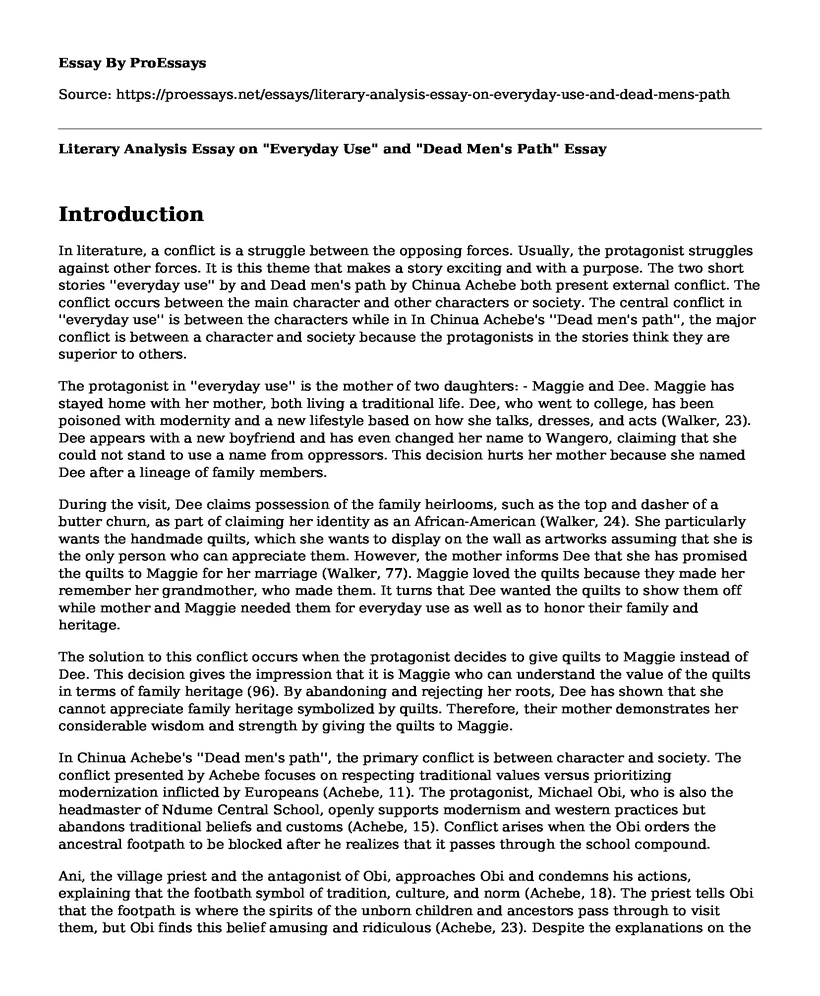Introduction
In literature, a conflict is a struggle between the opposing forces. Usually, the protagonist struggles against other forces. It is this theme that makes a story exciting and with a purpose. The two short stories ''everyday use'' by and Dead men's path by Chinua Achebe both present external conflict. The conflict occurs between the main character and other characters or society. The central conflict in ''everyday use'' is between the characters while in In Chinua Achebe's ''Dead men's path'', the major conflict is between a character and society because the protagonists in the stories think they are superior to others.
The protagonist in ''everyday use'' is the mother of two daughters: - Maggie and Dee. Maggie has stayed home with her mother, both living a traditional life. Dee, who went to college, has been poisoned with modernity and a new lifestyle based on how she talks, dresses, and acts (Walker, 23). Dee appears with a new boyfriend and has even changed her name to Wangero, claiming that she could not stand to use a name from oppressors. This decision hurts her mother because she named Dee after a lineage of family members.
During the visit, Dee claims possession of the family heirlooms, such as the top and dasher of a butter churn, as part of claiming her identity as an African-American (Walker, 24). She particularly wants the handmade quilts, which she wants to display on the wall as artworks assuming that she is the only person who can appreciate them. However, the mother informs Dee that she has promised the quilts to Maggie for her marriage (Walker, 77). Maggie loved the quilts because they made her remember her grandmother, who made them. It turns that Dee wanted the quilts to show them off while mother and Maggie needed them for everyday use as well as to honor their family and heritage.
The solution to this conflict occurs when the protagonist decides to give quilts to Maggie instead of Dee. This decision gives the impression that it is Maggie who can understand the value of the quilts in terms of family heritage (96). By abandoning and rejecting her roots, Dee has shown that she cannot appreciate family heritage symbolized by quilts. Therefore, their mother demonstrates her considerable wisdom and strength by giving the quilts to Maggie.
In Chinua Achebe's ''Dead men's path'', the primary conflict is between character and society. The conflict presented by Achebe focuses on respecting traditional values versus prioritizing modernization inflicted by Europeans (Achebe, 11). The protagonist, Michael Obi, who is also the headmaster of Ndume Central School, openly supports modernism and western practices but abandons traditional beliefs and customs (Achebe, 15). Conflict arises when the Obi orders the ancestral footpath to be blocked after he realizes that it passes through the school compound.
Ani, the village priest and the antagonist of Obi, approaches Obi and condemns his actions, explaining that the footbath symbol of tradition, culture, and norm (Achebe, 18). The priest tells Obi that the footpath is where the spirits of the unborn children and ancestors pass through to visit them, but Obi finds this belief amusing and ridiculous (Achebe, 23). Despite the explanations on the need to uphold cultural practices and norms, Obi refuses to reopen the footpath, leading to the death of a woman during childbirth the same night. To solve this conflict, the villagers decided to destroy the beautiful school garden, leading to Obi being fired.
Conclusion
In conclusion, the two short stories present external conflicts that occur between the protagonists and other forces. The primary conflict in everyday use'' occurs between a mother and a daughter. In Dead men's path'', the central conflict is between character and society. To solve this struggle, the mother denies her arrogant daughter the quilts and gives them to her humble daughter. In contrast, the solution to the conflict in ''Dead men's path'' is the destruction of the school garden accompanied by the sacking of the headmaster.
Work Cited
Achebe, Chinua. A Study Guide for Chinua Achebe's "Dead Man's Path". Detroit, Michigan: Gale, Cengage Learning, 1953.
Walker, Alice. Everyday use. New Jersey: Rutgers University Press, 1994.
Cite this page
Literary Analysis Essay on "Everyday Use" and "Dead Men's Path". (2023, May 12). Retrieved from https://proessays.net/essays/literary-analysis-essay-on-everyday-use-and-dead-mens-path
If you are the original author of this essay and no longer wish to have it published on the ProEssays website, please click below to request its removal:
- Hamlet's Relationship With Gertrude
- The Portrayal of Human Love in the Poem Lady Mary Wroth's Pamphilia to Amphilanthus
- Essay Prompts on Success or Failure in School and 'The Road Not Taken' by Robert Frost
- With the Old Breed by Eugene Sledge: The Mental Cost of War Essay
- Creativity and Rationality in Charlotte Gilman's The Yellow Wallpaper
- Maus: A Survivor's Tale Summary by Art Spiegelman - The Graphic Narrative of the Holocaust
- Essay on Frankenstein Experiment: Challenge on Ethics and Morality







